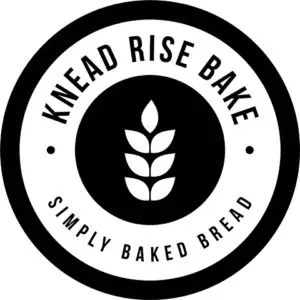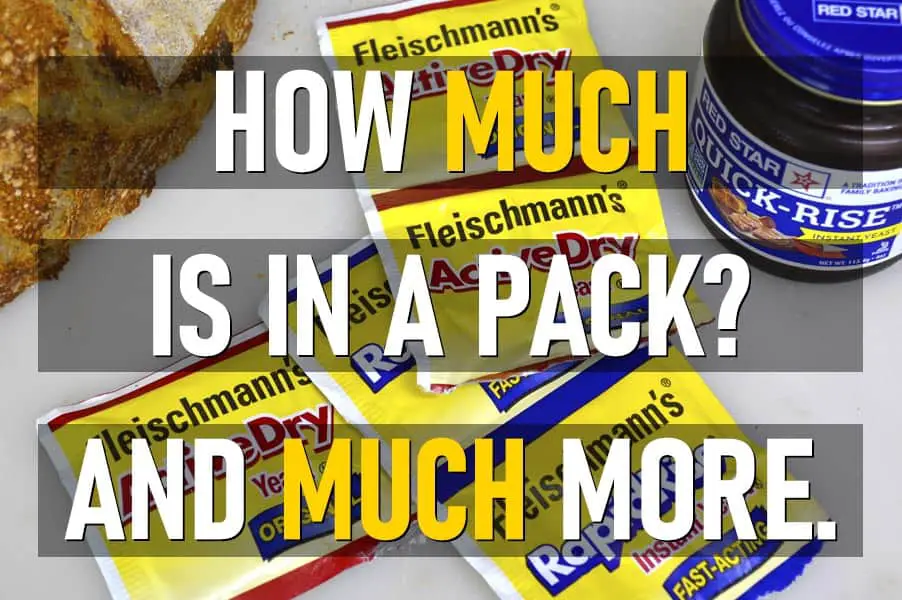Every experienced home baker has asked these questions at least once over the years. And if you’re like me, maybe too many times to want to admit. 🙂
Let’s dive right in and answer all your questions about commercial yeast (hopefully).
How Much Yeast is In A Packet of Yeast?
All major brands and varieties of commercial yeast contain 2 1/4 teaspoons of yeast which is equivalent to 7 grams in weight. There might be a slight variance in weight depending on the variety, but it will roughly weigh 7 grams.
The variance in weight comes down to packaging and how fine instant yeast or bread machine yeast is compared to active dry. We rarely see a difference, but from time to time see one come in at 8 grams. Not enough variance to make a difference in your baking.
What’s the Difference Between Instant, Rapid Rise, Bread Machine, and Active Dry varieties.
There is very little difference between instant, rapid rise, and bread machine yeast as they are all fine powders that are manufactured to be added directly into a bread recipe. Active Dry is slightly different in that it is more coarse and designed to be dissolved in a liquid before being added to a recipe. Each of these yeast varieties will perform very similarly.
The three powder versions can be added to water like rapid rise, and conversely, active dry can be used without dissolving in water like the others. The caveat is that active dry does take longer to activate in a recipe than it does in water.
We actually prefer blooming (waking yeast up in water) before any recipe to ensure that the yeast is potent. It only takes a few minutes more time and is more than worth saving us the trouble of having to wait all day for dough to rise. This is true whether we are using the powder options (instant, rapid, bread machine) or active dry.
Can I use Instant, Rapid, Bread Machine, and Active Dry interchangeably?
Instant, rapid rise, bread machine, and active dry yeast can all be used interchangeably with just one caveat about active dry. If using active dry in a recipe that calls for one of the other varieties, it should be bloomed in water first.
There might be a slight variance in rising times but ultimately will come down to minutes not hours. For the most part, other than waking up active dry in a liquid, nothing else changes in the recipe. Use the same amount of yeast the recipe calls for.
And yes, as long as active dry has been given a blooming period in water it can be added to a bread machine recipe. Just make sure you use some of the water from the recipe to bloom, otherwise, you’ll have far too much liquid in your dough.
Can I Use More or Less Commercial Yeast Than a Recipe Calls For?
Using more or less yeast than a recipe calls for is perfectly acceptable and primarily alters the amount of time dough will take to rise. Using more will result in a faster rise, while using less will result in a slower rise.
Depending on how much more or less yeast is used, the rise period might differ by a few minutes or several hours. For example, a basic recipe with 500 grams of flour might take just 1 hour to rise in a warm room with a packet of commercial yeast. That same recipe with 1/4 of a teaspoon of yeast (2 teaspoons less) could take anywhere between 12-18 hours to rise.
Also note, that excess yeast can result in tough textures and bitter bread. A single packet of yeast (2 1/4 teaspoons) for 500 grams flour is pushing the higher limits unless other ingredients like sugar and milk are added to help offset some of the downfalls of heavily yeasted bread.
Does Commercial Yeast Expire?
Commercial yeast has a best by date but does not include an expiration date. Most varieties and brands will have a shelf life of 4-6 months if unopened. Opened packages should be stored in a refrigerator and can be kept 4-6 months as well.
It is important to note, that like many other baking products, predicting when a food item will expire is nearly impossible. There are too many variables involved to do so. What many manufacturers do then is use a best by date (not an expiration date) that ensures their product will taste, smell, and perform at its peak.
For dry commercial yeast varieties, they are much more likely to go dormant before they expire or go bad. However, many bakers will tell you that they’ve kept yeast around for years in their fridge and never had any issues with it rising dough.
We’re not food safety experts and cannot tell you what to do for safety purposes, only that dry yeast can actually bloom up nicely much longer than the best by date suggests. So the best by date seems to be very conservative when it comes to the rising power of yeast.
Again, we cannot stress enough that we’re just home bakers, not experts on food safety. You should not take this as advice about using or not using yeast past the best by date. Please use your best judgment. 🙂
Can I Combine Different Varieties of Commercial Yeast in Recipes?
Different varieties of commercial yeast can be combined in recipes without altering the recipe. The primary difference between each commercial variety of yeast is how quickly it activates, which is typically only a matter of minutes.
Like with many of the other suggestions above, it would be best to bloom active dry yeast, but isn’t needed. Just keep track of your rising times, it might be a few minutes faster or slower.
Is Commercial Yeast Gluten-Free?
Many varieties and brands of commercial yeast are gluten-free and made in a dedicated factory to be specifically gluten-free products. However, not all varieties and not all manufacturers can be labeled as gluten-free. It is best to check with the manufacturer.
Can I Kill Commercial Yeast?
Yes, commercial yeast can be killed off if it is heated up to above 140 degrees. Some yeast will actually begin to die off once temperatures go above 120 degrees.
Active dry, according to manufacturers (source) is more sensitive to heat than other varieties and should be kept under 110 degrees.
Does Active Dry Yeast Need Sugar To Activate?
Active dry yeast performs best when activated in warm water before using, which is called blooming or proofing (proving), but does not need sugar to do so. Sugar is commonly used during this activation stage as it is a touch faster and causes an exaggerated amount of froth to form during the activation step which makes it easier to know when the yeast is active.
If choosing to use sugar, it only needs to be a pinch to speed things along and cause the froth. But, even without the sugar proving only takes about 5-10 minutes. Additionally, you can use other sweeteners like honey to achieve the same effect.
What’s the Difference Between Rapid Rise and Quick Rise?
The difference between Rapid Rise and Quick Rise is primarily just the names. Rapid Rise and Quick Rise are manufactured by two different companies, thus given different names. Both are designed to activate quickly without needing to be bloomed or proofed with water before mixing.
Additionally, the two manufacturers use different strains of yeast. Each strain has a subtle difference in how they perform (source). However, for their intended purposes, there is little difference. They will both rise bread in about the same amount of time.
What’s the Difference Between Commercial Yeast and Sourdough?
We have an entire post on that here: Check it out!

